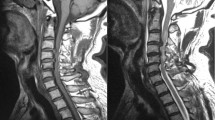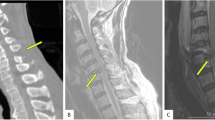Abstract
Purpose
Application of AOSpine subaxial cervical spine injury classification system to explore the optimal surgical decompression timing for different types of traumatic cervical spinal cord injury (CSCI).
Methods
A single-center prospective cohort study was conducted that included patients with traumatic CSCIs (C3–C7) between February 2015 and October 2016. After enrollment, patients underwent either early (< 72 h after injury) or late (≥ 72 h after injury) decompressive surgery of the cervical spinal cord. Each group was divided into A0, A1-4, B, C/F4 and F1-3 subgroups. The primary outcomes were ordinal changes in the ASIA Impairment Scale (AIS) and the Spinal Cord Independence Measure III (SCIM version 3) at a 12-month follow-up. The secondary outcomes included length of hospital stay, postoperative neurological deterioration, other complications and mortality.
Results
A total of 402 patients were included. Of these, 187 patients underwent early decompression surgery, and 215 patients underwent delayed decompression surgery. Statistical results included the following comparisons of the early vs late groups: AIS improvement ≥ 1 grade (combined groups: P < 0.0001; A0: P = 0.554; A1-4: P = 0.084; B: P = 0.013; C/F4: P = 0.040; F1-3: P = 0.742); AIS improvement ≥ 2 grades, P = 0.003 for all groups; SCIM version 3 (combined groups: P < 0.0001; A0: P = 0.126; A1-4: P = 0.912; B: P = 0.006; C/F4: P = 0.111; F1-3: P = 0.875).
Conclusion
Type A and F1-3 fractures are not required to undergo aggressive early decompression. Type B and type C/F4 fractures should receive early surgical treatment for better clinical outcomes.
Graphical abstract
These slides can be retrieved under Electronic Supplementary Material.



Similar content being viewed by others
References
Newton D, England M, Doll H, Gardner BP (2011) The case for early treatment of dislocations of the cervical spine with cord involvement sustained playing rugby. J Bone Joint Surg Br 93:1646–1652. https://doi.org/10.1302/0301-620x.93b12.27048
Fehlings MG, Vaccaro A, Wilson JR, Singh A, Cadotte DW, Harrop JS, Aarabi B, Shaffrey C, Dvorak M, Fisher C, Arnold P, Massicotte EM, Lewis S, Rampersaud R (2012) Early versus delayed decompression for traumatic cervical spinal cord injury: results of the Surgical Timing in Acute Spinal Cord Injury Study (STASCIS). PLoS ONE 7:e32037. https://doi.org/10.1371/journal.pone.0032037
Wilson JR, Singh A, Craven C, Verrier MC, Drew B, Ahn H, Ford M, Fehlings MG (2012) Early versus late surgery for traumatic spinal cord injury: the results of a prospective Canadian cohort study. Spinal Cord 50:840–843. https://doi.org/10.1038/sc.2012.59
Stevens EA, Marsh R, Wilson JA, Sweasey TA, Branch CL Jr, Powers AK (2010) A review of surgical intervention in the setting of traumatic central cord syndrome. Spine J 10:874–880. https://doi.org/10.1016/j.spinee.2010.07.388
Urrutia J, Zamora T, Campos M, Yurac R, Palma J, Mobarec S, Prada C (2016) A comparative agreement evaluation of two subaxial cervical spine injury classification systems: the AOSpine and the Allen and Ferguson schemes. Eur Spine J 25:2185–2192. https://doi.org/10.1007/s00586-016-4498-0
Vaccaro AR, Koerner JD, Radcliff KE, Oner FC, Reinhold M, Schnake KJ, Kandziora F, Fehlings MG, Dvorak MF, Aarabi B, Rajasekaran S, Schroeder GD, Kepler CK, Vialle LR (2016) AOSpine subaxial cervical spine injury classification system. Eur Spine J 25:2173–2184. https://doi.org/10.1007/s00586-015-3831-3
Silva OT, Sabba MF, Lira HI, Ghizoni E, Tedeschi H, Patel AA, Joaquim AF (2016) Evaluation of the reliability and validity of the newer AOSpine subaxial cervical injury classification (C-3 to C-7). J Neurosurg Spine 25:303–308. https://doi.org/10.3171/2016.2.spine151039
Urrutia J, Zamora T, Yurac R, Campos M, Palma J, Mobarec S, Prada C (2017) An independent inter- and intraobserver agreement evaluation of the AOSpine subaxial cervical spine injury classification system. Spine 42:298–303. https://doi.org/10.1097/brs.0000000000001302
Hadley MN, Walters BC, Grabb PA, Oyesiku NM, Przybylski GJ, Resnick DK, Ryken TC (2002) Management of combination fractures of the atlas and axis in adults. Neurosurgery 50:S140–S147. https://doi.org/10.1097/00006123-200203001-00022
Chappell ET (2002) Pharmacological therapy after acute cervical spinal cord injury. Neurosurgery 51:855
Bracken MB, Shepard MJ, Collins WF, Holford TR, Young W, Baskin DS, Eisenberg HM, Flamm E, Leo-Summers L, Maroon J et al (1990) A randomized, controlled trial of methylprednisolone or naloxone in the treatment of acute spinal-cord injury: results of the second national acute spinal cord injury study. N Engl J Med 322:1405–1411. https://doi.org/10.1056/nejm199005173222001
Ackerman P, Morrison SA, McDowell S, Vazquez L (2010) Using the spinal cord independence measure III to measure functional recovery in a post-acute spinal cord injury program. Spinal Cord 48:380–387. https://doi.org/10.1038/sc.2009.140
Wyndaele M, Wyndaele JJ (2006) Incidence, prevalence and epidemiology of spinal cord injury: what learns a worldwide literature survey? Spinal Cord 44:523–529. https://doi.org/10.1038/sj.sc.3101893
Furlan JC, Noonan V, Cadotte DW, Fehlings MG (2011) Timing of decompressive surgery of spinal cord after traumatic spinal cord injury: an evidence-based examination of pre-clinical and clinical studies. J Neurotrauma 28:1371–1399. https://doi.org/10.1089/neu.2009.1147
Liu Y, Shi CG, Wang XW, Chen HJ, Wang C, Cao P, Gao R, Ren XJ, Luo ZJ, Wang B, Xu JG, Tian JW, Yuan W (2015) Timing of surgical decompression for traumatic cervical spinal cord injury. Int Orthop 39:2457–2463. https://doi.org/10.1007/s00264-014-2652-z
La Rosa G, Conti A, Cardali S, Cacciola F, Tomasello F (2004) Does early decompression improve neurological outcome of spinal cord injured patients? Appraisal of the literature using a meta-analytical approach. Spinal Cord 42:503–512. https://doi.org/10.1038/sj.sc.3101627
Fehlings MG, Rabin D, Sears W, Cadotte DW, Aarabi B (2010) Current practice in the timing of surgical intervention in spinal cord injury. Spine 35:S166–S173. https://doi.org/10.1097/BRS.0b013e3181f386f6
Nakashima H, Nagoshi N, Fehlings MG (2015) Timing of surgery in the setting of acute spinal cord injury. Curr Surg Rep 3:1–9
Samuel AM, Grant RA, Bohl DD, Basques BA, Webb ML, Lukasiewicz AM, Diaz-Collado PJ, Grauer JN (2015) Delayed surgery after acute traumatic central cord syndrome is associated with reduced mortality. Spine 40:349–356. https://doi.org/10.1097/brs.0000000000000756
Croce MA, Bee TK, Pritchard E, Miller PR, Fabian TC (2001) Does optimal timing for spine fracture fixation exist? Ann Surg 233:851–858
Funding
No funds were received in support of this work.
Author information
Authors and Affiliations
Corresponding author
Ethics declarations
Conflict of interest
The authors have no conflicts of interest to declare.
Additional information
Publisher's Note
Springer Nature remains neutral with regard to jurisdictional claims in published maps and institutional affiliations.
Yong Fan and Jin‑Peng Du are both considered to be the first authors.
Electronic supplementary material
Below is the link to the electronic supplementary material.
Rights and permissions
About this article
Cite this article
Du, JP., Fan, Y., Zhang, JN. et al. Early versus delayed decompression for traumatic cervical spinal cord injury: application of the AOSpine subaxial cervical spinal injury classification system to guide surgical timing. Eur Spine J 28, 1855–1863 (2019). https://doi.org/10.1007/s00586-019-05959-6
Received:
Revised:
Accepted:
Published:
Issue Date:
DOI: https://doi.org/10.1007/s00586-019-05959-6




